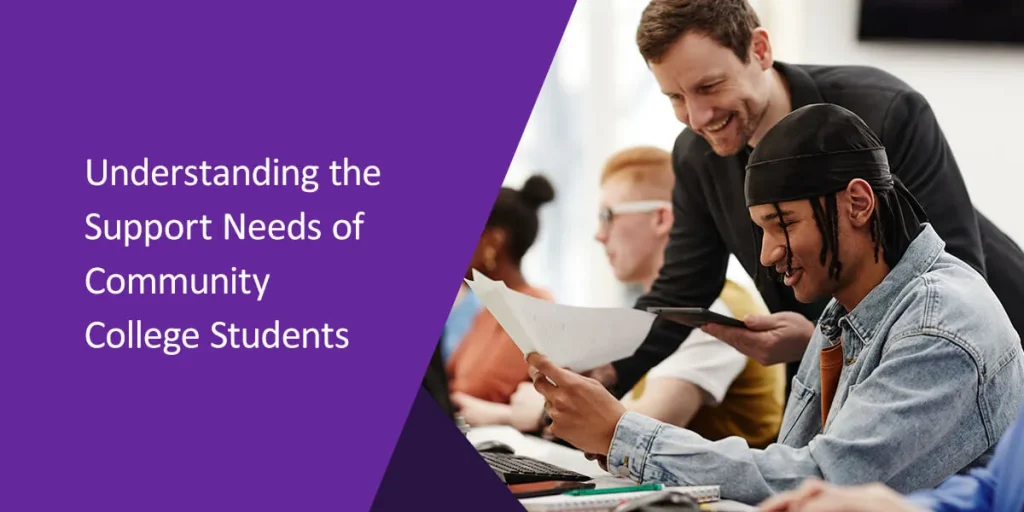




Community college students face various obstacles during their studies, sometimes leading to students dropping out of college. Understanding your students’ needs and providing essential support services can help them cope with their challenges and complete their degrees.
Academic services can no longer be the sole focus for community colleges. Leaders must focus on a holistic approach beyond academics and look at other priorities, such as family, work, and mental health. A student-focused, personalized strategy is essential to achieving successful outcomes for both the students and your college.
In this day and age, community colleges find themselves in a unique territory. Increasing tuition fees and cost of living, technological advances in higher education, and a hyper-competitive job market are unique challenges that today’s students face. While each student is different, these challenges are prominent across community colleges in the country.
Increasing tuition fees is a challenge faced by various higher education institutions. For years, community colleges have been an affordable option for underserved or low-income students. In 2022-2023, the average cost of attending a public two-year institution was $3,860. While this cost is considerably lower than other higher education institutions, many community college students need financial aid to afford these fees. Enrolling in a community college is a financial commitment that can be overwhelming for students who need funds. Due to a lack of finances, 51% of students drop out of college.
While technology is helping colleges make incredible strides in higher education, it also poses some difficulties for community college students. If the student is from an impoverished background, they may not have access to Wi-Fi. Lack of access to the Internet makes it difficult for these students to access college resources online. Many of these students may also need laptops or desktop computers.
College websites, online resources, and platforms should be accessible to all students. Students with disabilities, lower literacy skills, and diverse backgrounds must be able to navigate your college’s online platforms. For example, text alternatives for video or audio files on your website make material accessible for students with hearing impairments. If a student has slow Internet, they can read the text alternative instead of waiting for a video to load.
The rising cost of meeting basic needs and paying tuition fees leads to many students having to work. While working helps students to cover their expenses, many become overworked and need to play catch-up at college. Around two-thirds of students work 20 or more hours a week outside of college. Students who work outside college tend to achieve lower marks than those who don’t work and study full or part-time. There is little time to rest when students are constantly on the go at work, attending lectures, or completing assignments.
Some students may also be parents, which means they balance caring for children, working, and studying. When students are balancing all of these demands, finding time to relax is challenging. The lack of rest only adds to the stress they experience.
Community college leaders and support staff play a vital role in helping students achieve successful outcomes. Typically students at community colleges come from diverse backgrounds. They may come from low-income households, be parents or be a part of an underserved demographic, factors that make students vulnerable to dropping out of college. College staff can support students by bridging gaps and meeting students in their areas of lack.
Community college may be more affordable, but many students need financial assistance to enroll and complete their studies. Financial aid advising is a crucial support system that needs to be available to students. Financial advisors need to be there to help students make wise financial decisions. To ensure that students can stay enrolled and complete their degrees, it’s wise for your college to adopt these four strategies:
While most students can access a computer or the Internet for school purposes, some may experience connectivity or access problems. To support students with limited access to technology, your community college can adopt these initiatives to meet their connectivity needs:
Personal problems, unexpected life events, work, and family can all impact a student’s performance, no matter how prepared they are for college. Your community college can help students navigate and cope with life’s challenges through counseling, peer networks, and mentoring. While programs like these are significant investments, they can help retain students who risk dropping out because of stressful life factors. Counseling can help college students overcome and cope with their mental health, family, financial, and academic challenges.
Ease of accessibility is also crucial. Students must be able to get the support they need when they need it — this is where technology comes in. Online counseling sessions allow students to get help even off campus.

Giving college students a robust support system gives them a sense of belonging. Students want to know that their needs are meaningful to college leaders. While your college may provide solutions to support the needs of students, understanding whether these solutions are working and their impact on students will determine their success.
Each student is unique. Community college students come from a variety of backgrounds and demographics. It’s essential that student support staff gets to know their students and understand their needs, both academic and non-academic. Taking a personalized approach to getting to know your students helps staff guide students in their learning, helping them cope with and manage stress and ultimately navigate their academic journey to find what they are passionate about. Understanding each student’s unique needs enables you to equip them for professional success.
You may have a great support system available to students, but is it helping them? Student data gives you a holistic view of a student’s performance. Collecting and measuring data also shows you where there is room for improvement. For example, financial aid assessments can help you see whether every student is getting the help they need. Data can also trigger warning signs. If a student is skipping lectures or assignments, your college can intervene early on and provide the student with the support they need.
Diversity in faculty staff plays a crucial role in a student’s college experience. Students need the opportunity to relate to people from different backgrounds, races, and cultures to become more culturally aware. When students can have role models at college who have similar experiences, it gives them a sense of belonging. When hiring new staff, ensure you have a diverse pool of candidates. The faculty and staff of your college should mirror the diversity of the students you serve so that students can see examples of what they can achieve.

While community college students face challenges, your college can be part of the solution. Community college students are diverse: They may be parents, dual-enrolled high school students, from underserved groups, or have work obligations. Personalized support focusing on the student’s needs can ensure that your institution retains students and helps them succeed in their careers.
To learn more about Watermark solutions, contact our team today.





























































































































































































































































































































































































